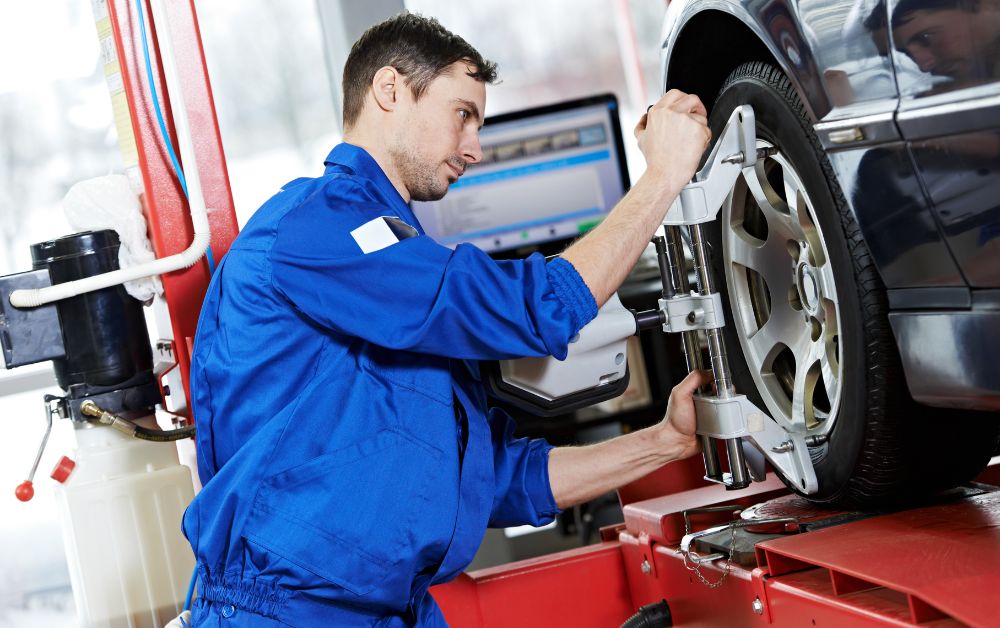How Often Should You Get a Car Alignment? A Comprehensive Guide

Maintaining your vehicle’s performance and safety involves various aspects, one of which is ensuring that your car’s wheels are properly aligned. Wheel alignment plays a crucial role in extending the life of your tires, improving fuel efficiency, and ensuring a smooth and safe ride. In this comprehensive guide, we will explore the importance of car alignment, signs that your vehicle needs an alignment, and how often you should get it done.
What is Wheel Alignment?
Wheel alignment refers to the precise adjustment of the angles of the wheels relative to each other and the car’s body. The primary angles adjusted during a wheel alignment are camber, caster, and toe. Camber refers to the vertical tilt of the wheels, caster relates to the angle of the steering axis, and toe describes the angle at which the tires point inward or outward when viewed from above.
Proper alignment ensures that the tires are making optimal contact with the road. When your wheels are correctly aligned, your car will handle better, provide a smoother ride, and improve tire longevity.
The Importance of Proper Alignment
- Tire Longevity: Misaligned wheels can cause uneven tire wear. For instance, excessive negative camber can lead to the inner edges of your tires wearing out faster, while positive camber can cause the outer edges to wear prematurely.
- Improved Fuel Efficiency: When your wheels are aligned, your tires roll more efficiently. Misaligned wheels can create additional resistance, reducing fuel efficiency. Maintaining proper alignment can help you save on fuel costs over time.
- Enhanced Handling: Proper alignment ensures that your car handles predictably. If your wheels are misaligned, your car may pull to one side, leading to safety concerns. With proper alignment, steering is more responsive and handling is improved.
Signs Your Car Needs Alignment
- Uneven Tire Wear: If you notice that the inner or outer edges of your tires are wearing down faster than the center treads, it’s a clear sign of misalignment. Such uneven wear patterns can be costly as it means you’ll need to replace your tires prematurely.
- Vehicle Pulling: When you release the steering wheel, and your car veers to one side, it’s a sign of misalignment. It happens because the tires are not aligned correctly and create unequal forces.
- Steering Wheel Off-Center: If your steering wheel is off-center even when you’re driving straight, it’s an indicator of misalignment. This can be not only annoying but also a sign that your car is not tracking correctly.
- Vibrations and Shaking: Misalignment can lead to vibrations or shaking in the steering wheel or the whole vehicle. This is often caused by an imbalance in tire wear due to misalignment.
When to Get Your Car Aligned?
1. Manufacturer Recommendations:
Refer to your vehicle’s owner’s manual for manufacturer-recommended intervals for wheel alignments. Typically, it’s advisable to get an alignment every 10,000 to 20,000 miles, but these recommendations can vary.
2. Driving Conditions:
If you frequently drive on rough roads, encounter potholes, or engage in off-road driving, you may need alignments more frequently. These conditions can cause your wheels to go out of alignment sooner.
3. Maintenance Schedule:
Regularly scheduled maintenance can help you keep track of your alignment needs. When you take your car in for an oil change or other services, ask the mechanic to check your alignment. If they notice any issues, it’s a good time to address them.
4. Signs of Misalignment:
If you notice any of the signs mentioned earlier, such as uneven tire wear, pulling to one side, an off-center steering wheel, or vibrations, it’s a clear indication that your car needs an alignment, and you should not delay in seeking one.
DIY Alignment vs. Professional Alignment
DIY alignment can be tempting, but it’s generally not recommended unless you have the expertise and specialized tools. A professional alignment service ensures that the job is done correctly. Attempting a DIY alignment without the necessary equipment and knowledge can lead to more problems than solutions, potentially causing further misalignment or damaging your vehicle.
The Alignment Process
During a professional alignment, the technician uses specialized equipment to measure and adjust the angles of your wheels to match the manufacturer’s specifications. There are three primary types of wheel alignments:
- Front-End Alignment: This aligns the front wheels only and is appropriate for vehicles with a non-adjustable rear suspension.
- Thrust Angle Alignment: It aligns the front wheels to the rear axle. This type is crucial for cars with a solid rear axle, which can become misaligned.
- Four-Wheel Alignment: In this comprehensive alignment, all four wheels are adjusted, ensuring the most accurate alignment for vehicles with independent rear suspensions.
The Cost of Wheel Alignment
The cost of a wheel alignment can vary depending on various factors such as your location, the type of alignment, and whether additional services are needed (e.g., correcting suspension components). On average, a standard front-end alignment can cost between $50 and $75, while a four-wheel alignment may range from $100 to $150. It’s important to consider alignment as an investment in tire longevity, fuel efficiency, and overall safety.
Conclusion
Proper wheel alignment is not just about maintaining your tires but also about ensuring a safe and comfortable driving experience. It’s a vital aspect of responsible car ownership that directly impacts tire longevity, fuel efficiency, and handling.
By paying attention to the signs of misalignment and adhering to manufacturer recommendations, you can enjoy a smoother and safer ride while saving money in the long run. Whether you choose professional alignment services or attempt a DIY approach, the key is to prioritize alignment as an essential part of your vehicle’s maintenance routine.
Related Articles

What Brand of Tires Should I Stay Away From? Expert Advice and Recommendations
If you’re wondering, “What brand of tires should I stay away from?” – you’re in the right place. In this comprehensive guide, we’ll delve into some tire brands that may not meet your expectations and provide expert advice on making informed decisions for your vehicle.

How Much Car Registration Renewal Costs: A Comprehensive Guide
In this comprehensive guide, we delve into the intricacies of car registration renewal costs, shedding light on what influences these expenses and providing valuable insights for car owners. Whether you’re a seasoned driver or a new car owner, understanding the financial implications of car registration renewal is crucial. Let’s explore how much car registration renewal truly costs and what factors you need to consider.

How to Detail Your Own Car Like a Pro – Tips and Tricks
Detailing your car isn’t just about making it shine; it’s about preserving its beauty, enhancing its value, and protecting it from the elements. Whether you’re a novice or a seasoned enthusiast, this guide will equip you with the knowledge and techniques to achieve professional-level results right in your own driveway.

Top Automotive Affiliate Programs to Boost Your Earnings in 2024
The automotive industry is boasting a staggering $459 billion in accessories alone, with projections indicating a rise to $522 billion within three years. If you’re eyeing a slice of this revenue pie, tapping into the right affiliate programs is essential. Here’s a curated list of top automotive affiliate programs to fuel your earnings.




